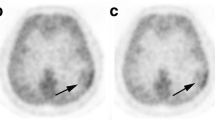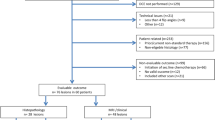Abstract.
Thallium-201, carbon-11 methionine (MET) and fluorine-18 fluorodeoxyglucose (FDG) have all been used to assess brain tumours. The aim of this study was to determine which of these tracers are of use for evaluating the histological grade and the extent of astrocytoma. 201Tl single-photon emission tomography (SPET), MET positron emission tomography (PET) and FDG PET were all performed in 23 patients (13 men, 10 women) with newly diagnosed astrocytic tumours [seven with astrocytoma (grade II), ten with anaplastic astrocytoma (grade III) and six with glioblastoma (grade IV)]. The 201Tl uptake of the tumours was evaluated by a lesion-to-normal region count ratio. Both MET and FDG uptake of the tumours was evaluated by a semiquantitative analysis using the standardized uptake value. 201Tl uptake was found to increase in rank order with histological grade and was significantly different among the three groups (grade II: 1.51±0.36; grade III: 2.58±1.50; grade IV: 7.65±3.84). MET uptake in grade II (1.49±0.44) was also significantly lower than that in both grade III (3.29±1.44) and grade IV (3.20±0.92). FDG uptake was not significantly different among the three groups (grade II: 2.90±0.45; grade III: 3.86±1.56; grade IV: 3.57±0.83). No significant correlation was observed between 201Tl uptake and either MET uptake or FDG uptake. In most patients, the extent of the increased MET uptake was the largest while that of the increased FDG uptake was the smallest. In patients with positive 201Tl uptake, the extent of the 201Tl uptake was equal to or smaller than that of gadolinium enhancement. For evaluation of histological grade of astrocytic tumours. 201Tl is therefore considered to be useful though the 201Tl uptake in some grade III astrocytomas was not different from that in grade II astrocytomas. MET was found to be highly useful for detecting astrocytomas, for differentiating between benign and malignant astrocytomas, and for evaluating the extent of astrocytomas; however, it was not sufficiently useful permit evaluation of the histological grade. FDG was not found to be useful either for evaluating the histological grade or for differentiating between benign and malignant astrocytomas.
Similar content being viewed by others
Author information
Authors and Affiliations
Additional information
Received 10 March and in revised form 11 May 1998
Rights and permissions
About this article
Cite this article
Sasaki, M., Kuwabara, Y., Yoshida, T. et al. A comparative study of thallium-201 SPET, carbon-11 methionine PET and fluorine-18 fluorodeoxyglucose PET for the differentiation of astrocytic tumours. Eur J Nucl Med 25, 1261–1269 (1998). https://doi.org/10.1007/s002590050294
Issue Date:
DOI: https://doi.org/10.1007/s002590050294




